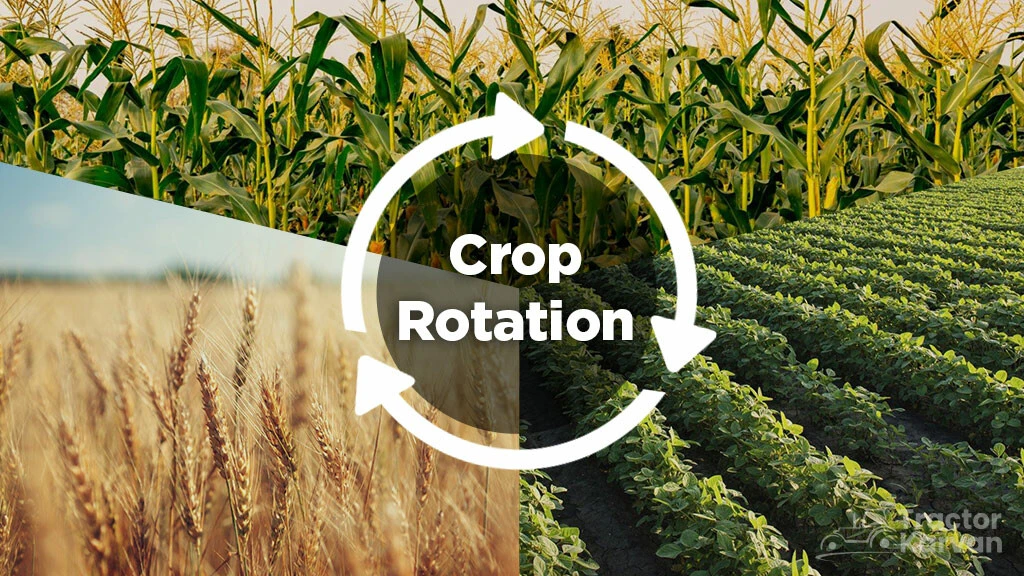Crop Rotation Method for India’s Sustainability

Table of Contents
- What is Crop Rotation
- Principles of Crop Rotation
- Benefits of Crop Rotation
- Considerations while Choosing Crops for the Crop Rotation
- Major Crops used in Crop Rotation with regions
- Difference between Crop Rotation and Intercropping
- Limitations of Crop Rotation
What is Crop Rotation
Planting two or more crops sequentially on the same plot of land to improve soil health, optimize nutrients, and combat pest and weed pressure is known as crop rotation. In crop rotation, the succeeding and previous crops are of different genus, species, subspecies or variety.
Crop rotation helps to achieve better soil quality and its physical, chemical and biological properties by adding organic matter in it. This method helps to keep the soil free from pests and diseases and to keep soil healthy. Farmers achieve higher yield without adding extra expenditure by making the best use of labour power and capital throughout the year.
Principles of Crop Rotation
- The crops with fibrous root system are followed by the crops with tap roots which helps in proper use of nutrients from the soil.
- The leguminous crops should be grown after non-leguminous crops. Legumes helps in fixing the atmospheric nitrogen and adds more organic matter to the soil.
- The crop of the same family act as alternate hosts for pests and diseases thus should not be grown in succession.
- There should be demand based and problem-based selection of the crops.
- The soil and climate conditions should match with the selection of the crops.
Benefits of Crop Rotation
- Increased soil fertility.
- Advantageous for the succeeding crops.
- Suppress the weed growth.
- Improves physical and chemical properties of the soil.
- Erosion free soil.
- Pest and disease control.
- Enhanced microbial activities.
- Elimination of toxic substances.
- Better soil nutrients utilization.
Considerations while Choosing Crops for the Crop Rotation
Choosing the right crop for the crop rotation can be tricky. We need to know some considerations which should be followed while choosing crops for the crop rotation. Let’s have a look on the major considerations below:
- Improved Soil Structure- Deep rooted crops should alternate with shallow-rooting crops to increase the soil structure.
- Enhanced Soil Fertility - High nitrogen demanding crops should alternate with system nitrogen-fixing crops to meet the soil requirements to make it more fertile.
- Weed and Pest Control - Slow-growing crops should follow weed suppressing crops because they are more susceptible to weed invasions.
Major Crops used in Crop Rotation with Regions
|
Crop Rotation |
Regions |
|
Rice-pulses, bajra-pulses, sorghum-pulses, groundnut-wheat, soybean-mustard, maize-pulses or clovers |
Across the country |
|
Rice-wheat; rice – maize; maize- wheat |
Irrigated areas |
|
Rice-pulses; rice-oilseeds; maize – pulses or oilseeds |
Rainfed regions |
|
Rice-mustard |
Eastern UP, Bihar and Northern West Bengal |
|
Rice- green gram/black gram |
Eastern India (Odisha, West Bengal) |
|
Rice-vegetable; sugarcane-wheat; wheat-vegetable; wheat-pulses; wheat-fallow; sorghum-berseem; maize-mustard; mustard-vegetable; maize-wheat |
Indo-Gangetic Plains |
Difference between Crop Rotation and Intercropping
- Planting two or more crops sequentially on the same plot of land to improve soil health, optimize nutrients, and combat pest and weed pressure while intercropping is planting two or more crops at the same time.
- Crop rotation prevents crop from pests and diseases while intercropping reduces the dependency on one crop.
- There is a method of alternatives of deep rooted and shallow rooted crops which increases soil fertility. On contrary, intercropping can make better use of space, water, nutrients and sunlight.
Limitations of Crop Rotation
- Requirement of different equipment and machinery based on different crops.
- Allopathic effect of preceding crop.
- Acts as an alternate host to pest and diseases.
Conclusion
Crop rotation is a smart and beneficial farming practice for the farmers. By adopting such farming practices, farmers can boost their crop yield, rejuvenates soil nutrients and improves soil fertility. Hence, we can say that this is a sustainable form of farming.
Frequently Asked Questions On Crop Rotation Method for India’s Sustainability
1. What are the advantages of intercropping and crop rotation?
Crop rotation increases soil fertility while intercropping reduces the risk of crop failure.
2. What do you mean by crop rotation?
Planting two or more crops sequentially on the same plot of land to improve soil health, optimize nutrients, and combat pest and weed pressure is known as crop rotation.
3. How are crops selected for crop rotation?
Soil building, conserving the nutrients and weed and pest control are some major considerations to be followed while selecting crops for crop rotation.
4. Why is crop rotation important?
Crop rotation helps to achieve better soil quality and its physical, chemical and biological properties by adding organic matter.
5. How does crop rotation help soil fertility?
High nitrogen demanding crops alternates with system nitrogen-fixing crops which helps in soil fertility of the crop.
6. Why should we adopt crop rotation?
We should adopt crop rotation to rejuvenates soil nutrients and improves soil fertility.


Related Blogs















